大家好,我是潘 Sir,持续分享 IT 技术,帮你少走弯路。《鸿蒙应用开发从入门到项目实战》系列文章持续更新中,陆续更新 AI+编程、企业级项目实战等原创内容、欢迎关注!
ArkUI 提供了丰富的系统组件,用于制作鸿蒙原生应用 APP 的 UI,在制作 UI 时会经常遇到代码或样式重复问题,本文通过 ArkUI 提供的适配器实现代码复用。
一、样式复用
1.1 概述
当多个组件具有相同的样式时,若每个组件都单独设置,将会有大量的重复代码。为避免重复代码,开发者可使用@Styles或者@Extend装饰器将多条样式设置提炼成一个方法,然后直接在各组件声明的位置进行调用,这样就能完成样式的复用。
1.2 @Styles 方法
@Styles方法可定义在组件内或者全局,具体语法如下
@Entry@Componentstruct StylesPage { build() { Column() { Row({ space: 50 }) { Button('确认') .type(ButtonType.Normal) .backgroundColor(Color.Green) .compButtonStyle() //复用样式 .onClick(() => console.log('确认')) Button('取消') .type(ButtonType.Normal) .backgroundColor(Color.Gray) .compButtonStyle() //复用样式 .onClick(() => console.log('取消')) } }.width('100%') .height('100%') .justifyContent(FlexAlign.Center) }
//组件内样式定义 @Styles compButtonStyle() { .width(100) .height(40) .borderRadius(10) }}
复制代码
@Entry@Componentstruct StylesPage { build() { Column() { Row({ space: 50 }) { Button('确认') .type(ButtonType.Normal) .backgroundColor(Color.Green) .globalButtonStyle() //复用样式 .onClick(() => console.log('确认')) Button('取消') .type(ButtonType.Normal) .backgroundColor(Color.Gray) .globalButtonStyle() //复用样式 .onClick(() => console.log('取消')) } }.width('100%') .height('100%') .justifyContent(FlexAlign.Center) }}
//全局样式定义@Styles function globalButtonStyle() { .width(100) .height(40) .borderRadius(10)}
复制代码
注意
组件内的@Styles方法只能在当前组件中使用,全局的@Styles方法目前只允许在当前的.ets文件中使用
组件内定义@Styles方法时不需要使用function关键字,全局的@Styles方法需要使用function关键字
@Styles方法中只能包含通用属性方法和通用事件方法
@Styles方法不支持参数
示例代码
pages/component 目录下新建 resue 目录,新建 StylesPage.ets 文件
@Entry@Componentstruct StylesPage { build() { Column() { Row({ space: 50 }) { Button('确认') .type(ButtonType.Normal) .backgroundColor(Color.Green) .compButtonStyle() //复用样式 // .globalButtonStyle() //复用样式 .onClick(() => console.log('确认')) Button('取消') .type(ButtonType.Normal) .backgroundColor(Color.Gray) .compButtonStyle() //复用样式 // .globalButtonStyle() //复用样式 .onClick(() => console.log('取消')) } }.width('100%') .height('100%') .justifyContent(FlexAlign.Center) }
//组件内样式定义 @Styles compButtonStyle() { .width(100) .height(40) .borderRadius(10) }}
//全局样式定义@Styles function globalButtonStyle() { .width(100) .height(40) .borderRadius(10)}
复制代码
1.3 @Extend 方法
@Extend装饰的方法同样可用于组件样式的复用,与@Styles不同的是,@Extend方法只能定义在全局。并且@Extend方法只能用于指定类型的组件,例如以下方法只能用于 Button 组件(可以理解为是 Button 组件的扩展样式)
@Extend(Button) function buttonStyle(){ ...}
复制代码
由于@Extend方法只能用于指定类型的组件,因此方法中可包含指定组件的专有属性方法和专有事件方法。另外,@Extend方法还支持参数,具体语法如下
@Entry@Componentstruct ExtendPage { build() { Column() { Row({ space: 50 }) { Button('确认') .buttonExtendStyle(Color.Green, () => console.log('确认')) //复用样式 Button('取消') .buttonExtendStyle(Color.Gray, () => console.log('取消')) //复用样式 } }.width('100%') .height('100%') .justifyContent(FlexAlign.Center) }}
//样式定义@Extend(Button) function buttonExtendStyle(color: Color, callback: () => void) { .width(100) .height(40) .borderRadius(10) .type(ButtonType.Normal) .backgroundColor(color) .onClick(callback)}
复制代码
总结
@Extend方法只能定义在全局,使用范围目前只限于当前的.ets文件
@Extend方法用于特定类型的组件,因此可包含该组件的专有属性方法和专有事件方法
@Extend方法支持参数
示例代码
pages/component/resue 目录下新建 ExtendPage.ets 文件
@Entry@Componentstruct ExtendPage { build() { Column() { Row({ space: 50 }) { Button('确认') .buttonExtendStyle(Color.Green, () => console.log('确认')) //复用样式 Button('取消') .buttonExtendStyle(Color.Gray, () => console.log('取消')) //复用样式 } }.width('100%') .height('100%') .justifyContent(FlexAlign.Center) }}
//样式定义@Extend(Button) function buttonExtendStyle(color: Color, callback: () => void) { .width(100) .height(40) .borderRadius(10) .type(ButtonType.Normal) .backgroundColor(color) .onClick(callback)}
复制代码
二、UI 结构复用
2.1 概述
当页面有多个相同的 UI 结构时,若每个都单独声明,同样会有大量重复的代码。为避免重复代码,可以将相同的 UI 结构提炼为一个自定义组件,完成 UI 结构的复用。
除此之外,ArkTS 还提供了一种更轻量的 UI 结构复用机制@Builder方法,开发者可以将重复使用的 UI 元素抽象成一个@Builder方法,该方法可在build()方法中调用多次,以完成 UI 结构的复用。
2.2 语法说明
@Builder方法同样可以定义在组件内或者全局,具体语法如下
@Entry@Componentstruct BuilderPage { build() { Column() { Row({ space: 50 }) { //复用UI结构 this.compButtonBuilder($r('app.media.icon_edit'), '编辑', () => console.log('编辑')) this.compButtonBuilder($r('app.media.icon_send'), '发送', () => console.log('发送')) } }.width('100%') .height('100%') .justifyContent(FlexAlign.Center) }
//定义UI结构 @Builder compButtonBuilder(icon: Resource, text: string, callback: () => void) { Button() { Row({ space: 10 }) { Image(icon) .width(25) .height(25) Text(text) .fontColor(Color.White) .fontSize(25) } }.width(120) .height(50) .onClick(callback) }}
复制代码
@Entry@Componentstruct BuilderPage { build() { Column() { Row({ space: 50 }) { //复用UI结构 globalButtonBuilder($r('app.media.icon_edit'), '编辑', () => console.log('编辑')) globalButtonBuilder($r('app.media.icon_send'), '发送', () => console.log('发送')) } }.width('100%') .height('100%') .justifyContent(FlexAlign.Center) }}
//定义UI结构@Builder function globalButtonBuilder(icon: Resource, text: string, callback: () => void) { Button() { Row({ space: 10 }) { Image(icon) .width(25) .height(25) Text(text) .fontColor(Color.White) .fontSize(25) } }.width(120) .height(50) .onClick(callback)}
复制代码
注意
组件内的@Builder方法可通过this访问当前组件的属性和方法,而全局的@Builder方法则不能
组件内的@Builder方法只能用于当前组件,全局的@Builder方法导出(export)后,可用于整个应用。
示例代码
拷贝 icon_edit.png 和 icon_send.png 文件到 resources/base/media 目录
pages/component/resue 目录下新建 BuilderPage.ets 文件
@Entry@Componentstruct BuilderPage { build() { Column() { Row({ space: 50 }) { this.compButtonBuilder($r('app.media.icon_edit'), '编辑', () => console.log('编辑')) this.compButtonBuilder($r('app.media.icon_send'), '发送', () => console.log('发送'))
// globalButtonBuilder($r('app.media.icon_edit'), '编辑', () => console.log('编辑')) // globalButtonBuilder($r('app.media.icon_send'), '发送', () => console.log('发送')) } }.width('100%') .height('100%') .justifyContent(FlexAlign.Center) }
@Builder compButtonBuilder(icon: Resource, text: string, callback: () => void) { Button() { Row({ space: 10 }) { Image(icon) .width(25) .height(25) Text(text) .fontColor(Color.White) .fontSize(25) } }.width(120) .height(50) .onClick(callback) }}
@Builder function globalButtonBuilder(icon: Resource, text: string, callback: () => void) { Button() { Row({ space: 10 }) { Image(icon) .width(25) .height(25) Text(text) .fontColor(Color.White) .fontSize(25) } }.width(120) .height(50) .onClick(callback)}
复制代码
2.3 @Builder 方法参数传递规则
@Builder方法具有两种参数传递机制——按值传递和按引用传递。当只有一个参数且参数为对象字面量时为按引用传递,其余情况均为按值传递。
按引用传递时,若传递的参数为状态变量,则状态变量的变化将会触发@Builder方法内部 UI 的刷新;按值传递时则不会。
示例代码
pages/component/resue 目录下新建 BuilderParameterPage.ets 文件
@Entry@Componentstruct BuilderParameterPage { @State count: number = 0;
build() { Column({ space: 50 }) { //按值传递 valueTextBuilder(this.count) //按引用传递 referenceTextBuilder({ count: this.count }) Row({ space: 50 }) { Button('-1').onClick(() => { this.count--; }) Button('+1').onClick(() => { this.count++; }) } }.width('100%') .height('100%') .justifyContent(FlexAlign.Center) }}
@Builder function valueTextBuilder(count: number) { Text(`按值传递: ${count}`) .fontSize(30) .fontWeight(FontWeight.Bold)}
@Builder function referenceTextBuilder(obj: { count: number }) { Text(`按引用传递: ${obj.count}`) .fontSize(30) .fontWeight(FontWeight.Bold)}
复制代码
2.4 @Builder 方法和自定义组件的区别
@Builder方法和自定义组件虽然都可以实现 UI 复用的效果,但是两者还是有着本质的区别的,其中最为显著的一个区别就是自定义组件可以定义自己的状态变量,而@Builder方法则不能。
以下案例中,每个待办事项的 UI 结构都相同,因此可考虑将其提炼为一个自定义组件或者@Builder方法,但是由于每个待办事项均有已完成和未完成两种状态,因此需要为每个待办事项都定义一个状态变量,所以此时就只能使用自定义组件而不能使用@Builder方法。
总结
若复用的 UI 结构没有状态,推荐使用@Builder方法,否则使用自定义组件。
示例代码
pages/component/resue 目录下新建 DifferencePage.ets 文件
@Entry@Componentstruct DifferencePage { build() { Column({ space: 10 }) { Text('待办事项') .fontSize(30) .fontWeight(FontWeight.Bold) .width('100%') TodoItem({ text: '读书' }) TodoItem({ text: '运动' }) TodoItem({ text: '早睡' }) } .width('100%') .height('100%') .justifyContent(FlexAlign.Start) .padding(10) .backgroundColor('#f2f2f2') }}
@Componentstruct TodoItem { text: string; @State isDone: boolean = false;
build() { Row() { Text(this.text) .fontSize(30) .fontWeight(FontWeight.Medium) //文本装饰线,根据isDone的值选择不同的类型 .decoration({ type: this.isDone ? TextDecorationType.LineThrough : TextDecorationType.None })
//用于填充Column/Row容器的剩余空间 Blank()
Toggle({ type: ToggleType.Checkbox }) .onChange((value) => { this.isDone = value; }) } .width('100%') .height(60) .backgroundColor(Color.White) .padding(10) .borderRadius(10) }}
复制代码
2.5 @BuilderParam
@BuilderParam用于装饰自定义组件(struct)中的属性,其装饰的属性可作为一个 UI 结构的占位符,待创建该组件时,可通过参数为其传入具体的内容。(其作用类似于 Vue 框架中的 slot)。
@Componentstruct Container { //@BuilderParam属性 @BuilderParam content: () => void
build() { Column() { Text('其他内容') //其他内容 this.content(); //占位符 Button('其他内容') //其他内容 } }}
复制代码
@Builder function contentBuilder1() { ...}
@Builder function contentBuilder2() { ...}
@Builder function contentBuilder3() { ...}
复制代码
Container({ content: contentBuilder1 })
Container({ content: contentBuilder2 })
Container({ content: contentBuilder3 })
复制代码
下面通过一个案例展示@BuilderParam的具体用法,例如,现需要实现一个通用的卡片组件,如下图所示
卡片中显示的内容不固定,例如
具体实现步骤如下:
(1)卡片组件定义
@Componentstruct Card { @BuilderParam content: () => void; //@BuilderParam属性
build() { Column() { this.content(); //占位符 }.width('90%') .padding(10) .borderRadius(10) .shadow({ radius: 20 }) }}
复制代码
效果
(2)卡片内容定义
@Builder function imageBuilder() { Column({ space: 10 }) { Image($r('app.media.img_harmony')) .width(300) .height(150) Text('鸿蒙操作系统') }}
复制代码
效果图
(3)创建卡片组件
Card({ content: imageBuilder })
复制代码
另外,如果一个组件中只定义了一个@BuilderParam属性,那么创建该组件时,也可直接通过**"子组件"**的方式传入具体的 UI 结构,例如
创建卡片组件
Card() { Column({ space: 10 }) { Text('鸿蒙操作系统') .fontSize(25) .fontWeight(FontWeight.Bold) Text('鸿蒙操作系统是...') }}
复制代码
效果图
示例代码
pages/component/resue 目录下新建 BuilderParamPage2.ets 文件
@Entry@Componentstruct BuilderParamPage2 { build() { Column({ space: 50 }) { //创建卡片组件(传参) Card({ content: imageBuilder })
//创建卡片组件("子组件") Card() { Column({ space: 10 }) { Text('鸿蒙操作系统') .fontSize(25) .fontWeight(FontWeight.Bold) Text('鸿蒙操作系统是一款由华为公司开发的多设备统一操作系统,致力于实现无缝连接和协同工作。其采用分布式架构,支持多终端智能互联,提供高效、安全、流畅的用户体验。') } } }.width('100%') .height('100%') .justifyContent(FlexAlign.Center) }}
//卡片内容@Builder function imageBuilder() { Column({ space: 10 }) { Image($r('app.media.img_harmony')) .width(300) .height(150) Text('鸿蒙操作系统') }}
//卡片组件@Componentstruct Card { @BuilderParam content: () => void; //@BuilderParam属性
build() { Column() { this.content(); //占位符 }.width('90%') .padding(10) .borderRadius(10) .shadow({ radius: 20 }) }}
复制代码
《鸿蒙应用开发从入门到项目实战》系列文章持续更新中,陆续更新 AI+编程、企业级项目实战等原创内容,防止迷路,欢迎关注!



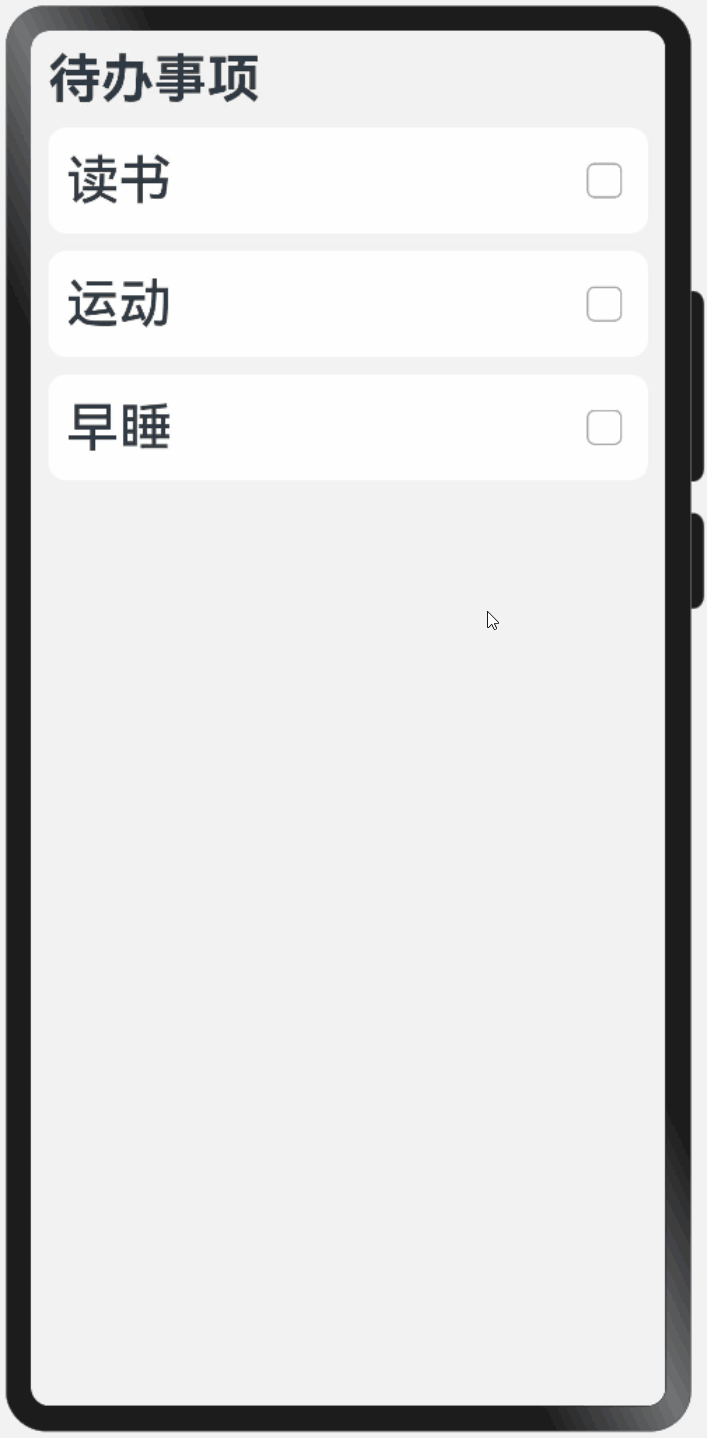
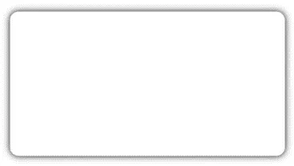
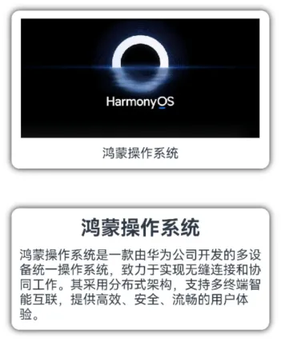

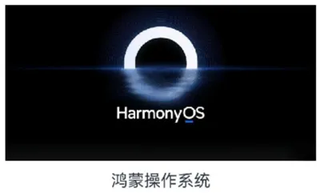
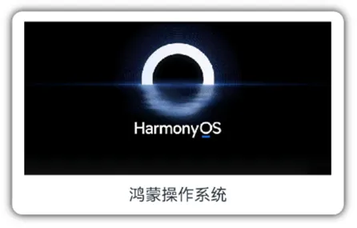
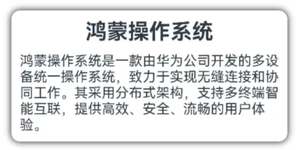








评论